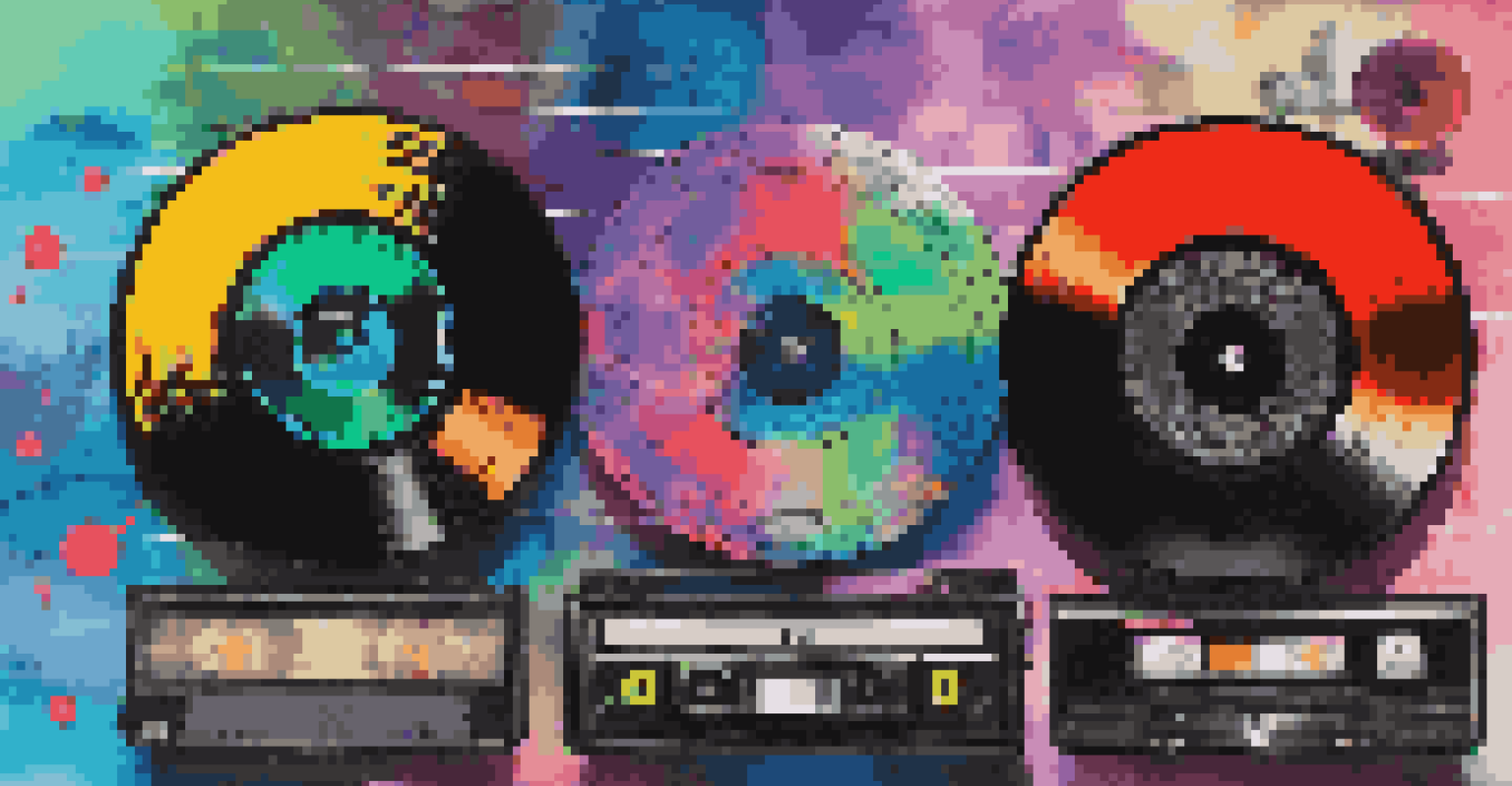How Video Streaming Services are Changing the Music Landscape

The Rise of Video Streaming Platforms in Music
Over the past decade, video streaming services like YouTube, TikTok, and Spotify have transformed how we consume music. No longer confined to just audio, these platforms offer a visual experience that enhances engagement with songs. Artists now have the opportunity to create music videos and live performances that reach global audiences in an instant.
Music is the shorthand of emotion.
This shift has not only changed how listeners experience music, but it has also created new revenue streams for artists. For instance, TikTok has paved the way for viral challenges that can catapult a song to fame overnight, demonstrating the power of video in music promotion. As a result, the traditional music landscape is evolving rapidly, adapting to the preferences of a more visually-oriented audience.
Moreover, the integration of music and video has allowed for a more immersive storytelling experience. Music videos are no longer just promotional tools; they are artistic expressions that can captivate viewers and deepen their connection to the music. This evolution invites artists to experiment with visuals, leading to innovative content that resonates with fans on multiple levels.
Impact on Artist Discovery and Promotion
Video streaming services have democratized the music industry, making it easier for emerging artists to gain visibility. In the past, securing a record deal was often a barrier, but platforms like YouTube allow artists to upload their music directly, reaching millions without gatekeepers. This shift empowers musicians to build their fanbase organically through creativity and consistency.

Moreover, algorithms on platforms like Spotify and Apple Music curate playlists that introduce listeners to new artists based on their preferences. This personalized approach means that even lesser-known musicians can find their audience, provided they create engaging content that resonates. It's a refreshing change from the days when radio play was the primary means of promotion.
Video Platforms Transform Music
Video streaming services have revolutionized music consumption by providing a visual dimension that enhances audience engagement.
Additionally, the viral nature of social media can propel an unknown artist into the spotlight overnight. A catchy song featured in a trending video can lead to millions of streams and a dedicated following. This has led to a culture where every artist has the potential to be 'discovered' through a single video, significantly lowering the barriers to entry in the music industry.
Shifts in Revenue Models for Musicians
The revenue landscape for musicians has undergone a significant transformation due to video streaming services. Traditionally, artists relied heavily on album sales and physical merchandise for income. However, platforms like YouTube and TikTok have introduced new monetization methods, allowing artists to earn from views, ads, and sponsorships.
The future of music is in our hands, and it’s up to us to shape it.
For example, YouTube's Partner Program enables creators to monetize their content through ads, giving musicians a chance to earn revenue from their music videos. Furthermore, TikTok's Creator Fund offers financial rewards for popular content, incentivizing artists to share their music in creative ways. This shift encourages artists to think outside the box when it comes to promoting their work.
However, it's essential to note that while opportunities have expanded, so have challenges. Many artists find that the revenue generated from streaming doesn't equate to traditional album sales. This has sparked discussions around fair compensation in the digital age, pushing for changes that better support artists in this evolving landscape.
Changing Consumer Behavior in Music Consumption
With the rise of video streaming, consumers are shifting their music consumption habits. The convenience of accessing vast libraries of music and videos at any time has changed expectations. Listeners now want instant gratification, leading to a preference for streaming over traditional purchases like CDs or downloads.
Moreover, the visual aspect of music consumption has made it a more interactive experience. Fans are no longer just passive listeners; they actively engage with content, sharing their favorite videos and participating in trends. This level of involvement fosters a community around music, where fans feel connected to the artists they love.
Empowerment Through Artist Discovery
Emerging artists now have greater visibility and access to audiences without traditional gatekeepers, thanks to platforms like YouTube.
As a result, playlists and video compilations have become popular ways for consumers to discover and enjoy music. Curated content allows listeners to explore new genres and artists in a way that's both entertaining and convenient. This shift has led to a more diverse musical landscape, where various styles and cultures can thrive.
The Role of Social Media in Music Promotion
Social media platforms have become essential tools for artists to promote their music and connect with fans. From Instagram stories to TikTok videos, artists can share snippets of their work, behind-the-scenes content, and engage directly with their audience. This immediacy fosters a sense of intimacy that traditional media channels often lack.
Additionally, the viral potential of social media can significantly amplify an artist's reach. A well-timed post or a collaboration with a popular influencer can turn a song into a global sensation. This phenomenon underscores the importance of having a strong online presence, as artists can leverage their platforms to create buzz around new releases.
However, navigating this landscape requires artists to be strategic about their content. Engaging visuals, relatable storytelling, and authentic interactions are key to standing out in a crowded digital space. As the line between music and social media continues to blur, artists must adapt to these new dynamics to thrive.
Video Streaming and Genre Diversity
Video streaming services have played a pivotal role in promoting genre diversity within the music industry. With the ability to explore various styles through curated playlists and recommendations, listeners are more open to discovering music outside their usual preferences. This has led to a richer tapestry of sounds that reflects global influences.
Platforms like YouTube have made it easier for niche genres to find their audience. Whether it's K-Pop, indie rock, or world music, diverse artists can showcase their talent to a wider demographic. As a result, genres that may have previously been overlooked are gaining traction, fostering a more inclusive music scene.
New Revenue Models for Musicians
The shift to video streaming has changed how artists earn money, introducing monetization through views and sponsorships while also raising concerns about fair compensation.
This increased exposure has also encouraged collaborations across genres, blending styles in innovative ways. Artists are now more willing to experiment, leading to exciting fusions that resonate with a broader audience. The result is a music landscape that celebrates diversity, breaking down barriers and inviting listeners to explore new sonic territories.
Challenges and Opportunities for Traditional Labels
As video streaming services reshape the music industry, traditional record labels are facing both challenges and opportunities. The rise of independent artists and DIY promotion has pressured labels to adapt their business models. Many labels are reevaluating their strategies to remain relevant in this new era of music consumption.
However, this landscape also presents opportunities for collaboration. Labels can leverage the power of video streaming to promote their artists more effectively. By investing in high-quality music videos and engaging content, labels can enhance their artists' visibility and foster a stronger connection with fans.

Moreover, labels that embrace the digital shift can find success by supporting artists in navigating this evolving environment. By providing resources for marketing, social media management, and content creation, labels can empower artists to thrive in a space that prioritizes creativity and innovation. It's a time of transformation, and those who adapt will ultimately lead the way.